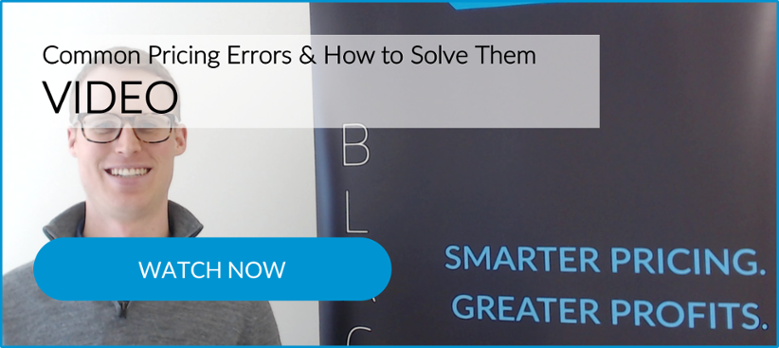If you have been reading BlackCurve's previous blogs, you will understand just how vital it is to the success of your business to get your prices right. Too high a price and your customers fade away, too low a price and your profits suffer.
We all make mistakes from time to time but get your pricing strategy wrong and you could be out of business within a very short space of time.
Here are a few major price errors that could potentially ruin your sales, please learn from them and hopefully avoid making the same errors again.
Price Error 1. I hardly ever update my prices
When did you last update your prices – was it 6 months or 6 years ago? Surely this can't be true? I suppose you believe that if things are going along relatively tickety-boo why should you rock the boat?
However, have you taken into account rising costs and inflation? At the very minimum you should be re-visiting your prices annually - and I stress minimum! There are many reasons for you to review/increase your prices on a more regular basis (even daily) but perhaps the most persuasive reason is that just a 1% increase can have a huge impact on your bottom line.
This could, on average, increase your company's net profits by 12%. You’ll probably also be pleasantly surprised at how little this price increase bothers most of your customers/clients.
Price Error 2. I believe "One Price Fits All"
Do you operate a single, narrow pricing policy for each of your products? If so you could be leaving money on the table.
“The mistake is to have only one price for your product.” - Nathan Barry
In a recent study in the States, pricing experts ran a test on selling beer. They priced one beer at $1.80 and one at $2.50. 80% opted for the more expensive beer. In this case, the lower priced product only served to emphasise and highlight the quality of the more expensive beer.
To further emphasise the impact of tiered pricing, the researchers ran a second test. This time they introduced a bargain price beer at $1.60. In this test, 80% of customers opted for the $1.80 beer (the middle one). Obviously, this was disastrous for profit margins.
Finally, the researchers removed the bargain beer and added a ‘super premium’ option at $3.40. In this test, 85% of customers opted for the $2.50 premium option. So, by simply offering more price options, this vendor was making an extra $0.70 (38%) per beer!
Price Error 3. I believe the lowest price always wins the sale
If your product or service is priced lower than all your competitors, you’ll get more business, right? Greater volume means you’ll make more money? Not always my friend.
This strategy only works if you’re selling exactly the same product as your competitors – and I mean exactly the same.
Today’s clued-up buyers tend to be sceptical, and the cheaper something is, they become suspicious. If it's cheap they will believe that it must be inferior in some way. Everyone loves a bargain but you don't want to discredit the reputation of what you are trying to sell - and indeed your company, by pricing at bargain-basement level.
Affordability is obviously important but buyers still want value. Instead of comparing your significantly lower prices to the competition, say why your prices are lower. What does your brand do differently that allows you to provide quality for less?
Price Error 4. I'm pricing too high
Setting prices too high without consideration for your target customers or what they value is a certain recipe for disaster.
When companies price their products too high, they can make attractive profits on each transaction. However, consumers are keenly aware of the value they get for their money, and once they conclude products are overpriced, they will stop buying. Believe me, consumers can have long memories and will be reluctant to trust your company again.
Price Error 5. I don't sell value
If you present products and services in the right light you can increase conversions. When dealing with pricier products, sell the value rather than just the product itself. Focus on the long-term benefits to the customer and demonstrate how the product or service can create a favourable change in your buyer’s lifestyle. Will it save time, improve efficiency, save the buyer money in the long run? These are all benefits to promote.
Price Error 6. I fail to benchmark my business
Business owners often tend to think of what a product should be worth, not what it is actually worth. It's important to study the whole market and to look at what the product sells for in your immediate area.
Observe your competitors, and think critically about how your model compares to theirs. What volume of business do your competitors do? Is there a reason their product sells for what it does? This is called benchmarking, and a remarkable number of small businesses fail to utilise this strategy.
Price Error 7. I have poor pricing presentation
You can have everything right about your pricing, but if you don’t present it in an appealing way, buyers aren’t going to be very impressed. Help build brand consistency by ensuring all pricing information you send to prospects looks clean, professional, and matches your organisation’s brand. You can even personalise the content.
The way you communicate pricing could completely lose you a deal. However, it's best not to complicate things without good reason. When in doubt, keep it simple.
Price Error 8. I still believe that Excel works for my price management needs
Traditionally for many businesses price management has been conducted using Excel spreadsheets to calculate optimum prices – and to convey these prices to all concerned in the sales process, your sales team and the customer.
However, the modern, accurate and more efficient way is to use a pricing software solution rather than the old fashioned methods that are so susceptible to error, manipulation and corruption.
Without a pricing system, it is hard to manage, test, and optimise alternative, more advanced pricing strategies such as psychological pricing, quantity based pricing, attribute-based pricing, and pricing differently across markets and geographies to name but a few.
Excel is also incapable of supporting quick decision making - you could easily miss out on a sale because of the time it takes to get the best price to your customer. The solution is to invest in pricing software that does all the calculations for you in real-time.
Pricing is a powerful lever
Pricing is an incredibly powerful lever that is typically underutilised. The most common price errors are either targeting the wrong customers or just pricing too low.
However, all things being equal, a good product and accurate pricing should mean the accumulation of a healthy profit. You can avoid the price errors mentioned in this post by using BlackCurve.
Related Posts
How to Avoid Making Pricing Errors
How to Minimise Pricing Errors
Sources
https://www.pricingsolutions.com/three-common-pricing-mistakes-and-how-to-avoid-them/
https://salesandmarketing.com/content/5-pricing-mistakes-avoid
http://postpressmag.com/stories/121415/common-pricing-mistakes.shtml#.V-koo63TUdU
https://hbr.org/2012/06/pricing-to-create-shared-value/ar/1
https://www.caycon.com/blog/2011/02/ten-top-product-pricing-models-for-startups/
https://www.americanexpress.com/us/small-business/openforum/articles/get-your-pricing-right/
The Strategy and Tactics of Pricing, Thomas Nagle and Reed Holden 2016



